Dell M6500: A Precision Strike on Bling
by Jarred Walton on March 9, 2010 3:00 AM ESTDell M6500 LCD Analysis: Beautiful but with Quirks
The LCD is the real wild card in this review. First, we need to make a note that there are several LCD options, and we're only looking at the anti-glare WUXGA panel with RGB LED backlighting. First impressions are extremely favorable: it's bright, with a good contrast ratio, and colors look vivid. Viewing angles are also among the best we've ever seen with a TN panel: you'll still get problems from above and below, but the usable angle is a bit wider than most laptops. The colors definitely look amazing, and there's no doubting Dell's claims of 100% Adobe RGB color gamut. (Note that you'll need to use an Adobe RGB color space to utilize the wider gamut; otherwise, the colors can look oversaturated.)
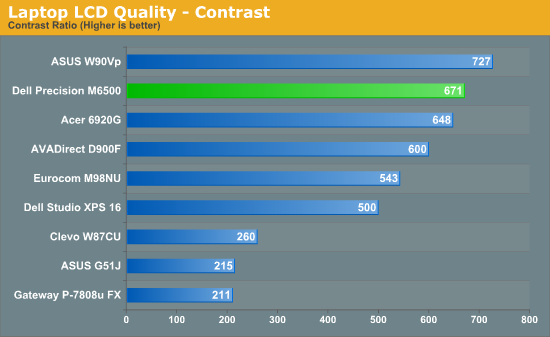
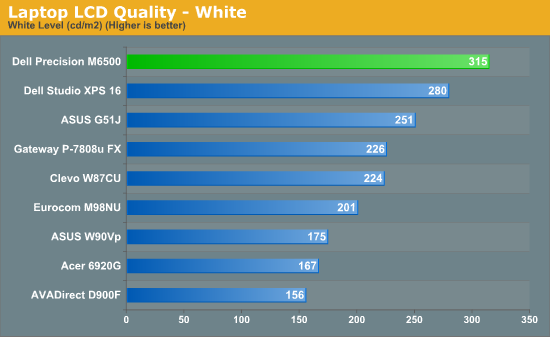
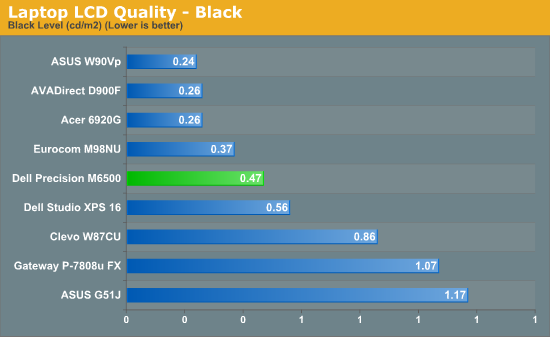

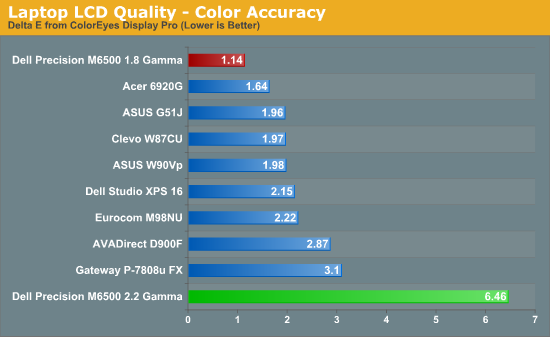
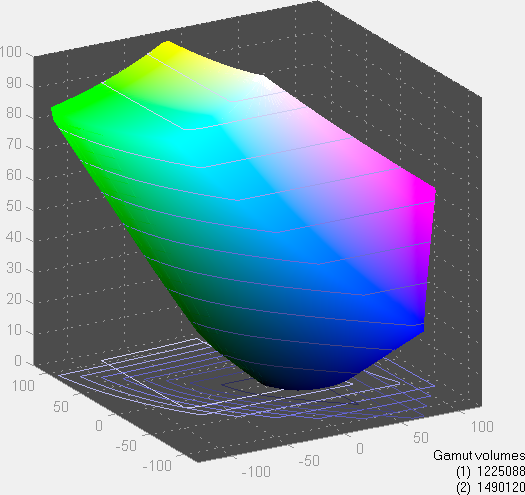

So the good news is that the LCD looks great, easily besting just about any laptop LCD I've used. The problem is that calibrating the LCD to display proper colors was… just… doesn't… work. I don't know what the problem is, but the LCD after calibration is still clearly off. Dell provides the ability to set the panel to NTSC, sRGB, or Adobe RGB color gamuts, but regardless of setting the calibrated results are off the charts. I tried ColorEyes Display Pro, Monaco Optix XR Pro, and LaCie Blue Eye Pro, all to no avail. I tried both a DTP-94 (it caused a BSOD in Vista and Win7) and an EyeOne Display 2 colorimeter. Nothing seemed to work right. At best, average Delta E is 6.5, even after calibration, with individual colors peaking at over 14.0.
There's definitely a cool (i.e. blue) tint at the default sRGB/aRGB settings, and regardless of setting I couldn't get the LCD to calibrate in a fashion that I would deem acceptable. I've had this problem only once before… on a Dell XPS M1730. In general, using the NVIDIA color control panel and turning down the blue about 20% gives a good result to my eye, but it's not possible to test that setting (any color profiling software overrides the NVIDIA control panel).
Update! You can see the above results for our original calibration attempts in gray. After posting the review, a helpful reader named Stephen gave us a pointer that allowed us to finally get a good result. (As an M6500 user/owner, Stephen noticed the same issues with the default settings.) He suggested we try a 1.8 gamma instead of the normal 2.2 gamma, and the change makes all the difference (see the added red line). If you don't know the difference between 2.2 and 1.8, here's a good explanation. The short summary is that Macs defaulted to a 1.8 gamma quite a while back while most other displays have stuck with 2.2. But that begs the question of why a Dell notebook running Windows appears to target a 1.8 gamma! Perhaps Dell wants people to make a Hackintosh out of the M6500? :-)
Regardless of the reason, using the NTSC profile (which appears to have no "tuning" of the LCD colors by Dell), and with the LCD brightness set to 40%/140nits, the color calibration results are polar opposites. We dropped from an average dE of 6.5 with peaks of 14+ to the best calibrated result we've seen from a laptop! How's that for a case of multiple personalities? The new result has an average dE of just 1.14, with only three of the tested 24 colors coming in above 2.0 and all of the colors coming in under 4.0. Wow! Thanks for the pointer, Stephen, but the real question is why Dell didn't address this in the first place?
We know from experience that Dell can provide exceptionally accurate colors if they choose—witness the uncalibrated results of the Dell U2711 for example. The problem is that more likely than not, the people involved with creating the color settings in the U2711 had nothing to do with the M6500 (or the M6400 before it). A BIOS/firmware update ought to be able to correct the problem, but we'd be surprised if Dell actually went that route. We've passed along our findings to Dell, so we'll have to see if a fix is forthcoming. Getting a good result at 1.8 gamma is nice, but when the standard for Windows is 2.2 it would be better to stick with the same settings that everyone else uses. In color managed applications, the final result will be great, but in non-managed applications you'll still get some wonky colors. That's too bad, considering everything else with the LCD is absolutely superb. It seems a waste to have a laptop with sRGB and Adobe RGB presets that appear to have no correlation with providing accurate colors. At the very least, the Adobe RGB profile (accessible from the Dell ControlPoint software) should be updated to give a result closer to the Adobe RGB setting in the U2711.
If you have appropriate calibration tools and software, I now feel comfortable saying that this is a great laptop for imagining/video professionals that depend on accurate colors, though desktop LCDs like the U2711 and 3008WFP are still better. Of course, that's only if you get the same LCD as our test M6500; we can't comment on the other panel options, and it's possible there will be a panel lottery resulting in differences between the "same" laptop configuration.















42 Comments
View All Comments
Nick-932 - Saturday, August 21, 2010 - link
Have you seen one in real life next to an Apple...Because all apples look like wimpsy flimsy notebooks comparing to an M6500.Additionally, they do not even have any spec similar as the M6500, even 8 months after their initial release.
jabber - Tuesday, March 9, 2010 - link
...but that 'thing' above the keyboard...????Didnt read the review actually as it's too expensive for me. So if what ever that thing is is explained as crucial then I apologise.
strikeback03 - Tuesday, March 9, 2010 - link
I read the review and still don't know. I was expecting an explanation of what the thing that looks like it was attached with a blob of caulk is on a laptop they think looks good.JarredWalton - Tuesday, March 9, 2010 - link
I guess you guys are referring to the FIPS fingerprint scanner? It's not "attached by a blob of caulk"... though I suppose the images don't quite convey what it actually looks like. Here's a better shot, if you didn't look at the gallery:http://images.anandtech.com/galleries/605/dell-pre...">http://images.anandtech.com/galleries/605/dell-pre...
It's an optional extra for security; rather than swiping your finger, you place it on that scanner. It's supposed to be more accurate than the swipe scanners.
jabber - Tuesday, March 9, 2010 - link
So why does it look bolted on?Lenovo manage to make a decent looking fingerprint scanner.
This thing is a mess. In fact the more I look at this laptop the more crap it looks.
Looks like a rough prototype.
JarredWalton - Tuesday, March 9, 2010 - link
Perhaps it looks better in person. The scanner is flush with the rest of the chassis, and about the only complaint I'd have with it is that the scanner has a gray border. Trust me, the chassis as a whole feels rock solid. I don't think it's the most awesome looking laptop ever created, but the LCD does look great and it's nice to see a large notebook I wouldn't be embarrassed about using in a business setting.Since you dislike the look of this notebook so much, what do you think makes for an attractive notebook? And please don't say MacBook Pro... they're fine, but you simply can't fit quad-core i7 with a Quadro FX 3800M into anything that thin. I'm actually quite impressed that the M6500 is "only" 1.3" thick!
jabber - Tuesday, March 9, 2010 - link
lol, no I wouldnt say a MacBook pro.However, I do find it baffling why manufacturers struggle to come up with something asthetically pleasing.
I do believe less is more, though it would be hard to design a laptop on that principle that wouldnt infringe on the mac design. They have reduced a design to it's near minimum.
I like the general look of my Inspiron 13Z though the 8 cell battery pack spoils the lines. It does mean however I can go 8 hours+ without power. The glossy plastics are also a big no-no.
If Dell just improved the build quality of say their Studio line with better/tougher plastics then that would go a long way.
DukeN - Tuesday, March 9, 2010 - link
Would truly have appreciated a Lenovo W5XX comparison here, or even a T500. TIA.hko45 - Tuesday, March 9, 2010 - link
Another reason to get this is the E-Port Plus docking (for all mobile Precision and most Latitudes -- I haven't seen anything comparable from anyone else). It allows the connection of two DVI or DisplayPort displays. That's what I use for my M6400 when I run PhotoShop & Lightroom. This should take care of any color issues. I would only use it as my first edit pass for my photos when on the road anyway. I'm definitely going to get an M6500 as soon as funds permit.geekforhire - Wednesday, March 10, 2010 - link
I received my Precision M6500 about a week ago, and in general I'm very happy.
Mine has the i7 Q720 processor, 64GB SSD, CD/DVD burner, 1440x900 RGBLED display, Intel 5300AGN Wifi card, 4GB memory, and Windows 7 Pro.
My previous notebook computer was 15.4" Dell Inspiron 8600, which I also designed, and served me well for 5.5 years. It failed about 6 months ago with a motherboard problem that would be expensive to replace - about as much as a netbook. At the time, I didn't want to spend alot of money on a replacement computer, so I got a netbook: Asus S101. It's a nice little (little!!!) machine, came with a Window XP Home on a 16GB SSD (note: they are now shipping with a 32GB SSD, which is actually livable, where the 16GB is definitely /not/ and later upgraded to 64GB). It does alot of things very well, but I eventually came to the conclusion that this was not enough computer for me. And if it failed I'd have to ship the computer away to the manufacturer for service - which would put me out of service for about 2+ weeks. So I bit the bullet, and got another real computer.
Loves:
Performance is excellent. This is safely the fastest notebook I've ever had the pleasure to work with - ever.
The display is excellent, displaying everything including movies with great sharpness, color quality, and contrast.
The keyboard has good touch, and the back-lighting is a nice touch that really should be included with every notebook.
Someone gave good though to the internal airflow, which allows the machine to be quiet and be effective even when resting on my lap with a comforter.
The SSD is giving snappy performance, but it's actual available physical C: size is 58.7GB, and there is the risk that the performance will decline over time (trim capability is unknown yet).
Fastest wifi performance I've ever measured: downloaded iTunes yesterday and the Network tab on the Task Manager showed an average 10.5% utilization with frequent peaks of 11.75% of a 54mbps wifi connection (I have a 7mbps DSL line to the internet with a high performance wifi router, but the Apple servers deserve some credit too).
The sound fidelity coming from the speakers is extremely good, especially for a notebook. Playing the movie "The Transporter" (music by Stanley Clarke), there were several very interesting sound positioning effect that many other speakers just won't present quite as well.
The built in webcam and array microphone work well. I'm having lots of great conversations with my daughter via Skype, who's on a 2 month trip in Ireland. Visual detail is good, and room echo of what I'm sending is low to non-existent.
I'm a believer in the Dell 4 year high end extended service warranty, and include it in all of the notebook computers that I design, because notebooks are subject to physical insults that desktop computers are not, and Dell will overnight ship replacement parts. Want to rent a great notebook computer for the price of a new great computer, here are 2 realistic human threats that tend to produce total loss: Dropping, and Liquid Spills.
Overall build quality is good. But it kind of better be with a machine this heavy, or else simple motions like lifting it from the front corner is going to cause the chassis to quickly split.
There are oodles of practical connectors and adapters built in, and I really like the slot-load CD/DVD drive.
Peeves:
The battery life seems to last about 2 hours, not the 3-4 hours I was designing for (I attribute this to the lowest end display card, which is much stronger and much higher power consuming than I wanted). I've played with the various power options and I've been able to improve the duration from the 1.5H that I seemed to first be getting when I received the machine, but I think 2.5H is going to be the wall.
The touch pad is left of where it should be. It's centered under the keyboard, rather than in the physical center of the computer, causing an awkward right hand "lunge" across to 1.5" left of where I naturally expect it to be. But I can recalibrate.
This machine and power brick are large and heavy, and are well served by backpack transport rather than something with just a single handle.
The low level light performance of the webcam in a dimly lit restaurant is fair, producing brownish grainy images. (reminder that the human eye has such an amazingly good sharpness even with wide variations of available light, that even modern DSLR technology comes no where near what the human eye can do so easily that we take that capability for granted.)
The machine was shipped about 3 weeks later than the original estimate. Note that this longer-than-expected actual ship date has happened with all other 17" Precision notebook computers that I've designed in the past.
Not sure yet about the 64 bit OS. There have been 1-2 weird freezing issues which I suspect the 32 bit OS may not experience; there is a compatibility issue with printing from a 64 bit machine to a printer attached to a 32 bit machine, but the effective work around is to print directly to the network attached printer. But having 4GB of available memory with a 64 bit OS is nicer than having 3GB of actually available memory on the same machine with a 32 bit OS. So the jury is still out on whether to reinstall with the 32 bit OS, or stick with the 64 bit OS.
In a nutshell, I can see myself growing old with this woman.